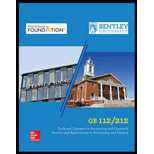
GB 112/212 MANAGERIAL ACC. W/ACCESS >C<
17th Edition
ISBN: 9781260218831
Author: Libby
Publisher: MCG CUSTOM
expand_more
expand_more
format_list_bulleted
Concept explainers
Question
Chapter 13, Problem 13.8P
To determine
Identify that the higher amounts for the given ratios reported by the companies A and B and explain the reasons.
Expert Solution & Answer
Want to see the full answer?
Check out a sample textbook solution
Students have asked these similar questions
Accounting?
Need help qui
sub accounting
Chapter 13 Solutions
GB 112/212 MANAGERIAL ACC. W/ACCESS >C<
Ch. 13 - Who are the primary users of financial statements?Ch. 13 - When considering an investment in stock, investors...Ch. 13 - How does product differentiation differ from cost...Ch. 13 - What are the two general methods for making...Ch. 13 - What are component percentages? Why are they...Ch. 13 - What is ratio analysis? Why is it useful?Ch. 13 - What do profitability ratios focus on? What is an...Ch. 13 - What do turnover ratios focus on? What is an...Ch. 13 - What do liquidity ratios focus on? What is an...Ch. 13 - What do solvency ratios focus on? What is an...
Ch. 13 - What do market ratios focus on? What is an example...Ch. 13 - Prob. 12QCh. 13 - Explain why rapid growth in total sales might not...Ch. 13 - A company has total assets of 500,000 and...Ch. 13 - Prob. 2MCQCh. 13 - Prob. 3MCQCh. 13 - Prob. 4MCQCh. 13 - Prob. 5MCQCh. 13 - Prob. 6MCQCh. 13 - Prob. 7MCQCh. 13 - Prob. 8MCQCh. 13 - Prob. 9MCQCh. 13 - Prob. 10MCQCh. 13 - Prob. 13.1MECh. 13 - Prob. 13.2MECh. 13 - Prob. 13.3MECh. 13 - Computing the Financial Leverage Percentage...Ch. 13 - Analyzing the Inventory Turnover Ratio A...Ch. 13 - Prob. 13.6MECh. 13 - Prob. 13.7MECh. 13 - Prob. 13.8MECh. 13 - Prob. 13.9MECh. 13 - Prob. 13.10MECh. 13 - Using Financial Information to Identify Companies...Ch. 13 - Prob. 13.2ECh. 13 - Prob. 13.3ECh. 13 - Prob. 13.4ECh. 13 - Prob. 13.5ECh. 13 - Prob. 13.6ECh. 13 - Prob. 13.7ECh. 13 - Prob. 13.8ECh. 13 - Prob. 13.9ECh. 13 - Prob. 13.10ECh. 13 - Inferring Financial Information from Ratios E13-11...Ch. 13 - Prob. 13.12ECh. 13 - Prob. 13.13ECh. 13 - Prob. 13.1PCh. 13 - Prob. 13.2PCh. 13 - Prob. 13.3PCh. 13 - Prob. 13.4PCh. 13 - Prob. 13.5PCh. 13 - Computing Comparative Financial Statements and...Ch. 13 - Analyzing Financial Statements Using Ratios Use...Ch. 13 - Prob. 13.8PCh. 13 - Prob. 13.9PCh. 13 - Prob. 13.1APCh. 13 - Prob. 13.2APCh. 13 - Calculating Profitability, Turnover, Liquidity,...Ch. 13 - Prob. 13.4APCh. 13 - Prob. 13.5APCh. 13 - Prob. 13.6APCh. 13 - Prob. 13.1CPCh. 13 - Prob. 13.2CPCh. 13 - Comparing Companies within an Industry Refer to...Ch. 13 - Prob. 13.4CPCh. 13 - Inferring Information from the DuPont Model Ratios...Ch. 13 - Prob. 13.6CP
Knowledge Booster
Learn more about
Need a deep-dive on the concept behind this application? Look no further. Learn more about this topic, accounting and related others by exploring similar questions and additional content below.Similar questions
- what is the total market value of the componys equity ? accounting questionarrow_forwardA promissory note has the following details: Principal: $5,000 . Term: 90 days . Interest: $150 Find the interest rate (Assume a 360- day year).arrow_forwardWhat is the amount of cash paid for interest in 2017?arrow_forward
arrow_back_ios
SEE MORE QUESTIONS
arrow_forward_ios
Recommended textbooks for you
 College Accounting, Chapters 1-27AccountingISBN:9781337794756Author:HEINTZ, James A.Publisher:Cengage Learning,
College Accounting, Chapters 1-27AccountingISBN:9781337794756Author:HEINTZ, James A.Publisher:Cengage Learning, Cornerstones of Financial AccountingAccountingISBN:9781337690881Author:Jay Rich, Jeff JonesPublisher:Cengage Learning
Cornerstones of Financial AccountingAccountingISBN:9781337690881Author:Jay Rich, Jeff JonesPublisher:Cengage Learning Financial Reporting, Financial Statement Analysis...FinanceISBN:9781285190907Author:James M. Wahlen, Stephen P. Baginski, Mark BradshawPublisher:Cengage Learning
Financial Reporting, Financial Statement Analysis...FinanceISBN:9781285190907Author:James M. Wahlen, Stephen P. Baginski, Mark BradshawPublisher:Cengage Learning Financial Accounting: The Impact on Decision Make...AccountingISBN:9781305654174Author:Gary A. Porter, Curtis L. NortonPublisher:Cengage Learning
Financial Accounting: The Impact on Decision Make...AccountingISBN:9781305654174Author:Gary A. Porter, Curtis L. NortonPublisher:Cengage Learning Intermediate Accounting: Reporting And AnalysisAccountingISBN:9781337788281Author:James M. Wahlen, Jefferson P. Jones, Donald PagachPublisher:Cengage Learning
Intermediate Accounting: Reporting And AnalysisAccountingISBN:9781337788281Author:James M. Wahlen, Jefferson P. Jones, Donald PagachPublisher:Cengage Learning

College Accounting, Chapters 1-27
Accounting
ISBN:9781337794756
Author:HEINTZ, James A.
Publisher:Cengage Learning,

Cornerstones of Financial Accounting
Accounting
ISBN:9781337690881
Author:Jay Rich, Jeff Jones
Publisher:Cengage Learning

Financial Reporting, Financial Statement Analysis...
Finance
ISBN:9781285190907
Author:James M. Wahlen, Stephen P. Baginski, Mark Bradshaw
Publisher:Cengage Learning

Financial Accounting: The Impact on Decision Make...
Accounting
ISBN:9781305654174
Author:Gary A. Porter, Curtis L. Norton
Publisher:Cengage Learning

Intermediate Accounting: Reporting And Analysis
Accounting
ISBN:9781337788281
Author:James M. Wahlen, Jefferson P. Jones, Donald Pagach
Publisher:Cengage Learning
Chapter 6 Merchandise Inventory; Author: Vicki Stewart;https://www.youtube.com/watch?v=DnrcQLD2yKU;License: Standard YouTube License, CC-BY
Accounting for Merchandising Operations Recording Purchases of Merchandise; Author: Socrat Ghadban;https://www.youtube.com/watch?v=iQp5UoYpG20;License: Standard Youtube License